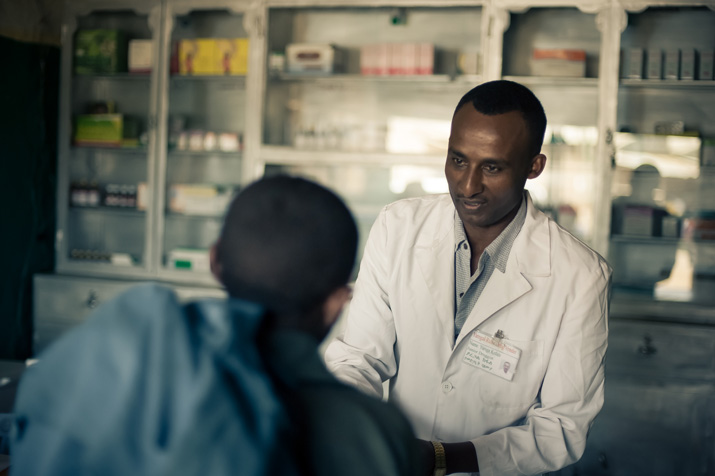Managing Medicines Benefits, Making Universal Health Coverage a Reality: A Conversation with Kwesi Eghan
Managing Medicines Benefits, Making Universal Health Coverage a Reality: A Conversation with Kwesi Eghan

Kwesi Eghan, MSC, MBA, BPHARM, is portfolio manager for the US Agency for International Development (USAID)-funded Systems for Improved Access to Pharmaceuticals and Services (SIAPS) program in South Sudan and Afghanistan. A pharmacist by training, Eghan co-authored MSH’s recently published Management of Medicines Benefit Programs in Low-and Middle-Income Settings, which is designed as a manual for countries to implement health benefit packages that reduce out-of-pocket expenses for medicines in the context of universal health coverage (UHC).
Why is a medicines benefits program important to universal health coverage?
Medicines are a key component of treatments to save lives. But they can be costly. They tend to be a significant portion of out-of-pocket expenses for individuals and households without social or financial protection—sometimes further impoverishing patients and families.
More than 80 percent of the time, anybody that goes to a GP [general practitioner], one of the interventions that they receive is medicine. Excluding medicines from financial protection programs implies exclusion of a significant chunk of the care that clients need. And if clients have to make that up with out-of-pocket [expenses], most will not be able to afford it. This is especially true in low- to middle-income countries.
We are also seeing that those countries that incorporate medicines benefits without the appropriate design elements and operational and governance systems, tend to have medicines becoming a runaway cost and having a negative impact on the financial sustainability of their programs.
Why is the issue of access to medicines important to you personally?
I am Ghanaian and I have also been to and supported pharmaceutical management activities in several other countries in Africa and East Asia, and I’ve seen how difficult it is for people who live in rural areas—and for some in big urban areas—to obtain medicines.
For many countries, medicines are not available. And when they are available, they are too expensive to procure. And even when they procure them, the knowledge around rational usage is also poor.
I have been close to scenarios where patients have died because they could not afford to continue chemotherapy after a month or two. I’ve seen it happen in Ghana. I know it is real—and I also realize that financial protection mechanisms with medicine benefits is one major vehicle to improve access.
Before this movement to have medicines benefits, what was the situation like in low- to middle-income countries if you needed medicine, but your insurance didn’t cover it?
It depends on how far back we want go. The beginnings of the UHC movement go as far back as the Bismarkian times for Germany and 1948 for the UK [United Kingdom] where both countries decided on universal health protection with medicines coverage for their citizens. Before these times, and in LMICs [low- and middle-income countries], varied systems existed but each had substantial out-of-pocket payment for medicines And about 50 to 60 percent of the out-of-pocket payments had been made for medicines. Then, in comes big universal health coverage programs, like national health insurance and social insurance programs. Some countries decided to cover only in-patient care without medicines. Others were covering outpatients and inpatients without medicines. The patients were still paying high out-of-pocket [expenses] because that medicines component was not covered.
Also, these countries do not have a production or local manufacturing presence and most import their pharmaceuticals. In some of these countries, the pharmaceutical sector tends to be seen as running on separate systems and sometimes seen as being outside the health system. But, increasingly we are realizing that pharmaceuticals play a major role and it is important to include pharmaceuticals through sustainable approaches.
What are some roadblocks to implementing the suggestions that are in the manual?
The UHC movement, conceptualization and initial design meetings are usually driven by governments, donors, ministries of finance. One of the roadblocks is that the people who can implement the concepts in the book are not being invited to the table. If people who are invited to the table do not have the background in terms of some of the concepts and approaches we have discussed and recommended, they may design amiss. That’s the first challenge.
For instance: How should countries select medicines to be covered under their insurance programs? How do they arrive at reimbursement prices for medicines? What process do they institute to enable revisions? Being able to understand that you need to adopt mechanisms that give the country the best value for money in terms of selection, procurement, distribution, claims managements for medicines is key.
What impact do you hope the medicines benefits manual will have?
It will serve as a guide for countries that are at different stages of universal health coverage development. For those starting out fresh, this book gives a clear message: you need to have people with expertise in pharmaceutical management to sit around a table with economists, finance experts, and actuaries to incorporate medicines at a design level.
The objective is to create awareness of the key considerations for designing a sustainable medicines benefit program in LMICs.
Ultimately, if people can better incorporate medicines in their [universal health coverage] programs, then we will be meeting the objective [of universal health coverage], which is to reduce out of pocket payments and ensure equitable access to quality care.
Related content: Management of Medicines Benefit Programs in Low- and Middle-Income Settings